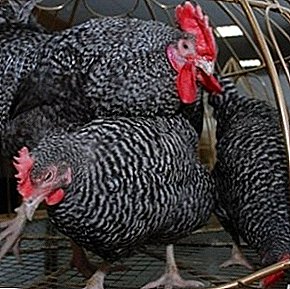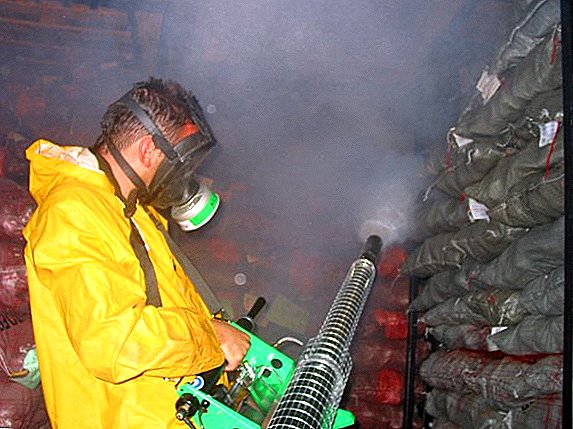 In livestock, it is important to comply sanitary and hygienic conditions in order to reduce the risk of infecting birds and animals with various infections and viruses. In this regard, at such enterprises and in veterinary clinics, measures are being taken to disinfect premises, equipment, tools and other assistive devices. One of the most popular means of disinfection is "Vyrotsid".
In livestock, it is important to comply sanitary and hygienic conditions in order to reduce the risk of infecting birds and animals with various infections and viruses. In this regard, at such enterprises and in veterinary clinics, measures are being taken to disinfect premises, equipment, tools and other assistive devices. One of the most popular means of disinfection is "Vyrotsid".
Description and release form
"Viricide" - It is a disinfectant concentrated product with the effect of foaming. In appearance it is a clear brown liquid, water-soluble, has a slight peculiar smell. It is produced in plastic canisters of 5, 10 and 20 liters. 
Did you know? The first mention of veterinary medicine appeared in ancient Egypt. Currently found Ebers papyrus, which describes the animals, their diseases and parasites.Virocid affects a wide range bacteria, viruses, fungi, molds, yeasts and algae. The active substances are in high concentration - 522 g / l. The tool does an excellent job with organic pollution, in hard water, with ultraviolet radiation, as well as at low temperatures. Along with this, the drug is not aggressive and safe to use. The following facts can also be attributed to the positive characteristics of this tool:
- does not promote corrosion on disinfectable surfaces;
- prolonged exposure period after treatment (up to 7 days);
- does not provoke the effect of resistance in microorganisms.
Disinfecting drugs used in veterinary practice: "Apimaks" and "Pharmaiod".

Composition and active ingredient
In the composition of "Virocide" 4 main components:
- the composition of quaternary ammonium compounds (alkyldimethylbenzylammonium chloride - 17.06% and didecyldimethylammonium chloride - 7.8%);
- glutaraldehyde - 10.7%;
- isopropanol - 14.6%;
- turpentine derivative - 2%.

Indications for use
Purpose of "Virotsida" - the implementation of preventive and involuntary disinfection in the field of veterinary medicine, namely for processing:
- poultry and livestock buildings, equipment located in them, ancillary facilities, special uniforms and packaging;
- industrial premises and the adjacent area, as well as technological equipment in the institutions of food and processing industries;
- vehicles operated in livestock;
- veterinary hospitals, nurseries, zoos and circuses.
Did you know? Livestock is one of the most ancient industries, which appeared in the Neolithic period. It arose as a result of man's domestication of wild animals and birds. Currently, about 30% of land is used for grazing.
How to apply "Viricide": dosage
Instructions for use of "Virotsida" in veterinary medicine provides for its planned use without the presence of animals, as well as forced disinfection in his help when the animals are in the cleaned premises. In general, the treatment is carried out in two ways:
- wet (rubbing, spraying, immersion in the solution);
- aerosol (through fog generators).

Check out other antibacterial drugs for animals: Enroflox, Enrofloxacin, Nitox Forte, Roncoleukin, Baytril and Enroxil.
For prophylaxis
For preventive purposes disinfection of premises and their equipment is carried out without the presence of animals. In front of it, the room should be cleaned and mechanically cleaned, and the surfaces should be washed with soapy water. For disinfecting treatment, it is necessary to prepare a 0.25-0.5% solution from the concentrate, diluting it with water. Consumption rate - 4kv.m / l. For aerosol disinfection prepare 20-25% solution, one liter is enough for processing 1000 cubic meters. m
For disinfection Incubation special equipment used 0.5% solution. For volumetric treatment using a fog generator, it is necessary to prepare a 5% solution of "Virocide".
Before handling vehicles, they must be cleaned with foaming detergents, then rinse off the foam and apply the Virocide solution (0.25-0.5%).
For processing tools preparing a 0.5-1% solution. Pre-equipment is soaked for 10 minutes in the preparation "DM Sid" (2%). The processing time "Virotsidom" - 30 minutes. Upon completion of all operations, the equipment must be rinsed with distilled water. 
For forced disinfection
Sometimes there is an urgent need for disinfection, then it is carried out when animals are in the premises.
Important! During the procedure, ventilation must be turned off.It is carried out in an aerosol manner with a solution with a share of "Virotsid" 0.5%. On one cubic meter of the room leaves from 2 to 5 ml of solution. For better distribution add glycerin (from 5 to 10% of the volume of the liquid).
Safety measures when using
When working in "Virotsidom" should avoid his contact with the skin and mucous membranes, for this all activities carried out in overalls, rubber gloves and a respirator. Eating and drinking, as well as smoking during the work is prohibited. After work, wash hands and face with plenty of water and soap and rinse the mouth.
When ingested solution into the body, you need to drink about 10 tablets of activated carbon and a couple glasses of water.
Important! At the slightest suspicion of poisoning, it is urgent to contact a medical institution for further assistance.

Contraindications
Restriction of use is hypersensitivity to the drug. Contact with skin and mucous membranes can cause irritation. It is forbidden to use for persons under the age of 18.
Read about other anti-infective drugs that are used to treat animals: Tromexin, Fosprenil, Baycox, and Solikox.
Terms and conditions of storage
Store means in the darkened and dry place inaccessible for children. The temperature range is very wide - from -20ºС to 50ºС. When these conditions are followed, it is suitable for use for three years from the date of issue. Working solution "Virotsida" should be used for 7 days.
"Virotsid" as a drug for disinfection proved himself very well. The best result will be if you strictly adhere to the recommended concentrations and be sure to carry out a preliminary cleaning in the premises.












